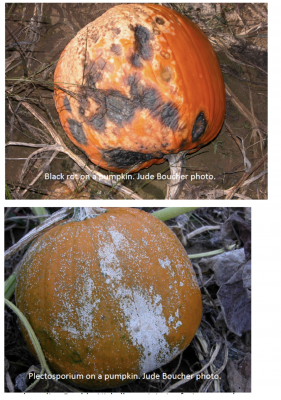By Jude Boucher, Retired UConn Extension Educator, Commercial Vegetable Crops
Pumpkin disease management begins with cultural and preventative controls such as proper site selection, field preparation and the use of resistant varieties. Some of the most effective alternative control measures include planting in well-drained soils on open sites with good air circulation, away from early cucurbit crops such as summer squash that may spread diseases, using powdery mildew-resistant varieties, and using deep zone tillage to improve soil drainage and protect fruit from rots.
Fungicide Program: Recent experiments at UConn showed that unsprayed pumpkins yielded less than half as much as plants with an effective fungicide program. There are four common and important diseases* you can help manage with a good fungicide program: powdery mildew, Plectosporium blight (Plecto), black rot (BR) and downy mildew. Powdery mildew (PM) tends to be the most common and the most important in many years, so we design the spray schedule around it. The basic idea is to slow disease spread with the fungicides by limiting spore formation, new leaf infections, and stem and fruit problems, so that you maximize your yields and net profits.
To determine when to make the first application for PM, scout 50 lower leaves each week after the plants run, and spray when you find the first small, round, colony of white powdery mildew spores (usually on the underside of the leaf). Then, continue to make applications at 10-day intervals until mid-September.
Systemic fungicides, which move through the plant or leaves, usually provide the most effective control of PM because it is impossible for any sprayer to provide good coverage where the infection first occurs: on the underside of the lower, older leaves, in a waist-high pumpkin patch. As part of your PM resistance management strategy, use each systemic family/group only one time each season. Unlike protectant fungicides that have several modes-of-action to stop infection, systemics tend to have a single mode-of-action which is easily skirted by the billions of spores encountered by the product. Add a protectant fungicide to the tank mix during each application to help slow resistance, and to provide control of Plecto and BR on fruit.
Currently, there are four effective systemic groups to choose from for PM control: fungicide resistance groups 3, U6, 7 and 13. So, if you choose one of the most effective products from each resistance group, your spray program in 2014 should look something like this: Torino (U6) + Bravo (i.e. chlorothalonil), Quintec (13) + Bravo, Procure (3) + Bravo, Pristine (7 & 11) + Bravo, and then switch to a mix of two protectants for the remainder of the season (sulfur + Bravo). This program uses the most effective systemic groups early in the disease cycle to restrict spread, and the less effective later. You could also skip the Pristine application because it is the most expensive, or mix the Pristine with a protectant such as sulfur or Dithane, to rest the Bravo, while still providing good protection against PM, Plecto and BR. Group 11 products are the most effective against Plecto if it becomes the major concern in your field.
Since this fungicide program is ineffective against downy mildew (DM), you usually need to add another mobile fungicide to your spray mix late in the season when (or if) this disease shows up. DM first appears as widely scattered, yellow spots or ¼-1/2 inch, yellow or brown squared-off spots on the leaves. If more than one DM application is needed, alternate between two effective products to slow resistance. Some of the more effective downy mildew products include: Ranman, Presidio, Previcur Flex, Revus, Tanos, Curzate, and in some years Dithane or a phosphorus acid-type material such as ProPhyt. You can also mix sulfur (protectant) and Tanos (systemic) to control all four diseases. Organic growers can mix sulfur for PM control with other broad-spectrum products (i.e. Double-Nickel) to minimize fruit rots and defoliation from DM.
*Recent research shows that you can also reduce problems with Phytophthora blight using preventative soil and foliar applications of certain fungicides (see ‘Chemical/Microbial Control of Phytophthora Blight’ – this issue). However, effective chemical control of all five pumpkin diseases may be cost prohibitive.
